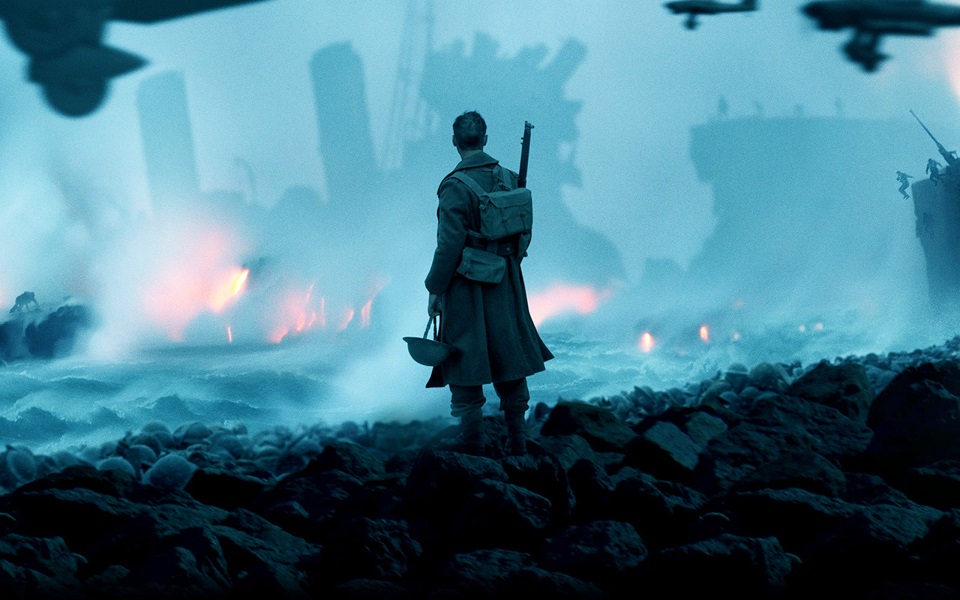After 2014’s Interstellar, Christopher Nolan’s next movie Dunkirk releases in theaters across major territories today. Unlike more recent Hollywood Blockbusters though, Dunkirk is shot exclusively in IMAX, embracing the format over 3-D instead. And if you have access to a nearby IMAX theater, there’s a strong reason why you should consider seeing it on such a screen.
Christopher Nolan has long been a vocal proponent of the older ways of shooting films. One of these is his preference for film stock – he almost always prefers shooting in film over digital, never mind the fact that the film has to be converted to digital and back anyway for color grading, visual effects work and other post-production activities. Yet another way in which he prefers old over new is his affinity for the large IMAX format over the new cash-cow that is 3-D.

A still from Dunkirk
Nolan believes IMAX and not 3-D is the way to go for large-scale cinematic experiences. In fact, he pioneered the use of IMAX in mainstream Hollywood after shooting over 30 minutes of The Dark Knight using IMAX cameras, one of the earliest blockbuster Hollywood movies to be shot in the format. Since then, numerous film-makers have followed suit, often combining IMAX with 3-D.
Nolan has made no exception for Dunkirk. In fact, if reports are to go by, at least 75% of the movie has been shot in the IMAX format a number that could even be as high as 100% according to some sources (i.e. the whole movie). Such a film can then only truly be enjoyed if it is seen in the IMAX format.
But why? What makes the IMAX format so special and so different?
One of the differences is in the aspect ratio. Explained in simple terms, a film’s aspect ratio is simply the ratio of its width to height. To better understand this concept, consider the two images below, both taken from the opening scene of Nolan’s The Dark Knight.

The Dark Knight as seen in Regular Theaters with an Aspect Ratio of 2.4:1

The Dark Knight as seen in IMAX Theaters with an Aspect Ratio of 1.77:1
The first of these images is wider as compared to the second, which is much taller. The first image has what we generally call a widescreen aspect ratio of 2.4:1 and is how you most commonly see your movies in the regular theaters that you watch them in. The second image on the other hand is much taller as opposed to being wider. It has an aspect ratio of 1.44:1 and is how the film looks like in IMAX theaters.
So what happens then if you watch a movie shot with IMAX cameras in a normal theater? The movie is cropped as below:

A Comparison of Aspect Ratios. The additional footage at the top and bottom shot with IMAX won’t be visible in a Regular Theater
As observed, you see less of the movie that was shot simply because the theater cannot accommodate the entire size of the movie. In some cases, theaters fit the movie at the cost of inserting black bars to the left and right. In this case, while you see exactly what was shot, you’re unable to make maximum use of the screen’s real-estate. Likewise, if a movie shot in the normal 2.35:1 format is shown in IMAX, you would see black bars at the bottom and top of the movie to fill up the IMAX screen properly in its own aspect ratio. Sometimes, a theater will switch between aspect ratios for the best experience – The Dark Knight and The Dark Knight Rises both employed this technique where they switched between the IMAX and the Regular Aspect Ratios in their IMAX screening to make maximum use of the tall IMAX screen.

Sometimes theaters fill in Black Bars at the sides to make up for the Aspect Ratio difference
Fun Fact: Your laptops do something similar. Laptops generally have an aspect ratio closer to the IMAX aspect ratio which is why most of the movies that you see in your laptop have black bars at the top and the bottom. On the other hand, the TV show episodes that you watch are generally shot in an aspect ratio closer to the IMAX ratio which is why you see them cover the entire laptop screen. This doesn’t mean TV show episodes are shot with IMAX cameras though but merely in a similar aspect ratio. As an aside, smartphones shoot in the same aspect ratio as well.
Yet another reason to see a movie shot in IMAX on IMAX screens is unparalleled clarity. An IMAX camera has about 16 times more resolution than a normal camera which results in an insanely clear image – sharper colors, brighter images and an almost HDR like quality to the scenes. However, you’ll only be able to see this difference in IMAX theaters; since normal theaters do not support this enhanced image projection.
Of course IMAX theaters are few and far between and not as widely available as the regular theaters are. In that case, do not hesitate to experience the movie in regular theaters. But if by any chance, you can get to an IMAX venue for the movie’s screening, do consider putting in the extra effort. With the clarity you’ll experience on screen, it should be totally worth it.
In any case, Dunkirk deserves to be seen on the big screen. It tells the events of Operation Dynamo, an important rescue mission that took place in 1940 between May 26 and Jun 4 which led to the evacuation of nearly 330,000 Allied soldiers from the shores of Dunkirk. The event is regarded as crucial in helping the Allied forces win the war against the Germans.
Dunkirk releases in the US, UK, India and several other major markets today, on July 21. Look out for our review of Dunkirk here on Appocalypse.





